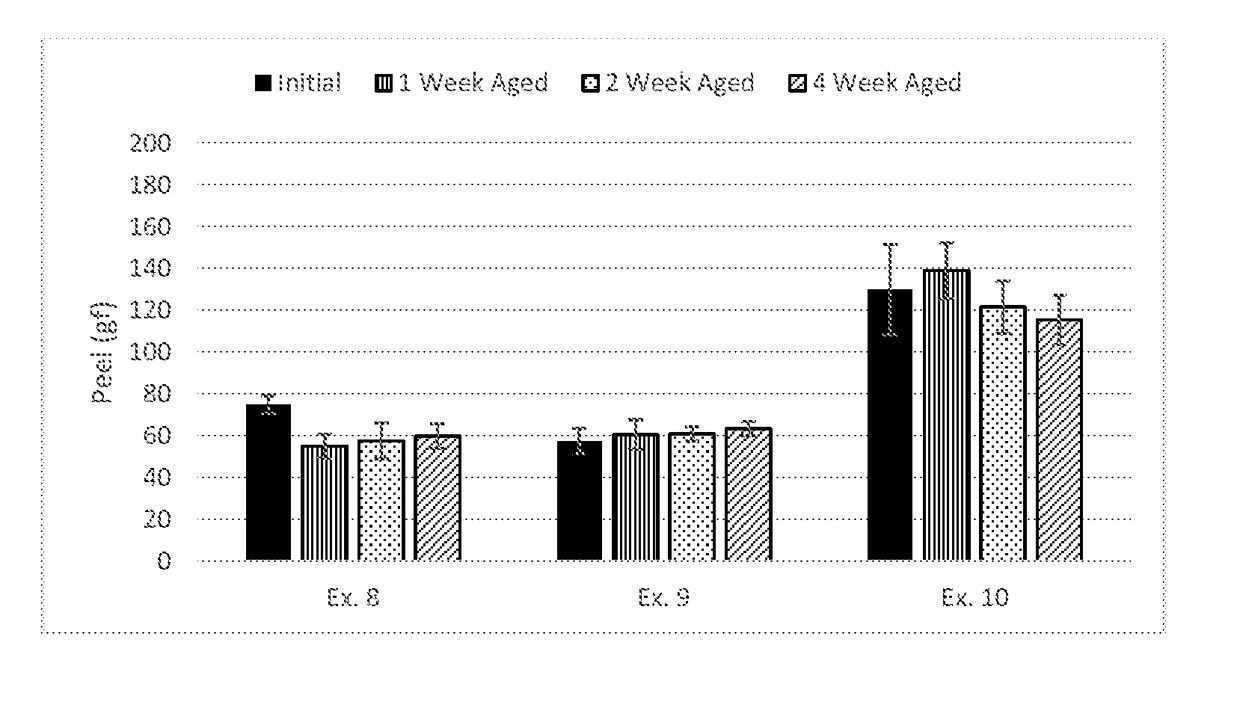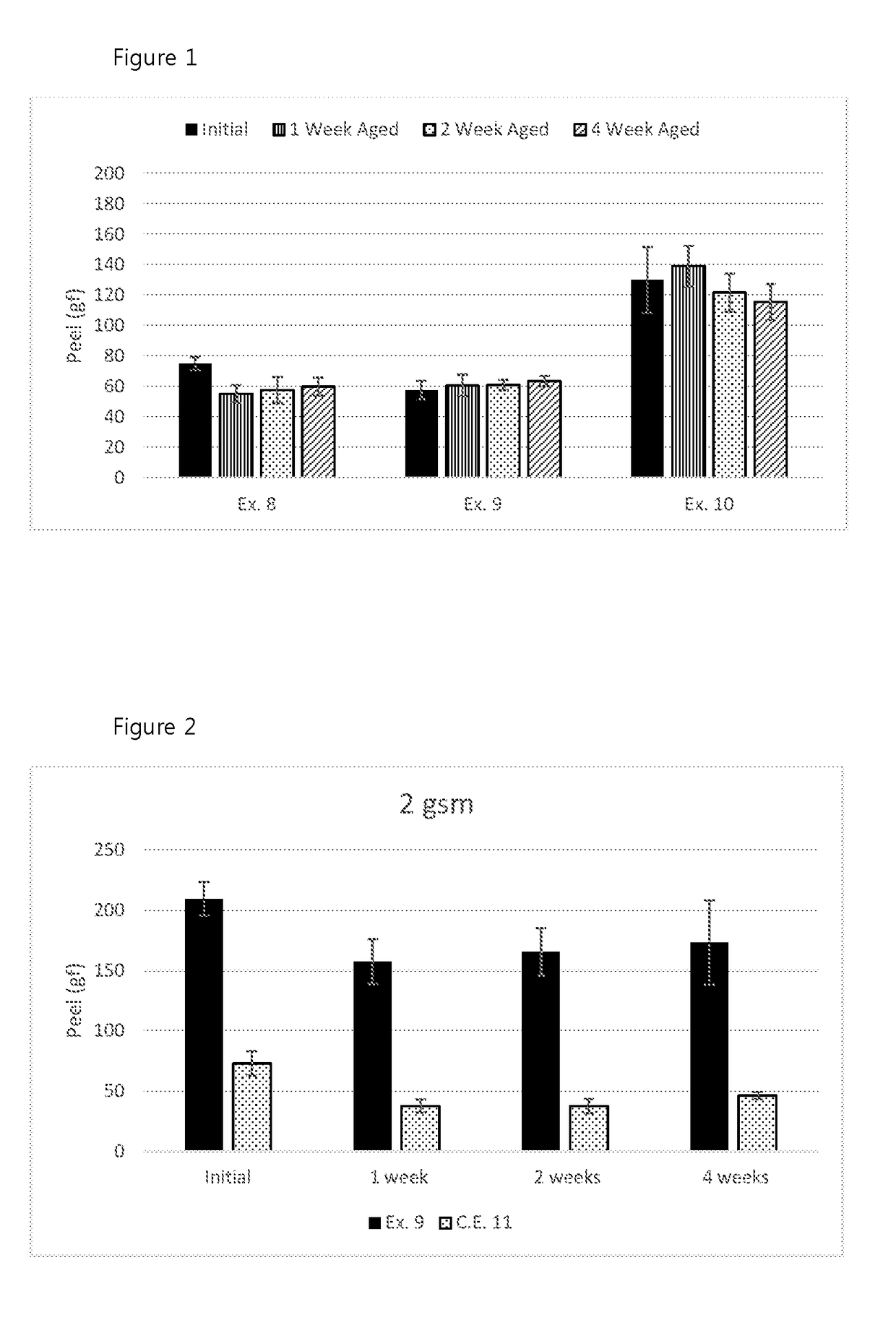Hot melt adhesives for bonding elastomeric components, nonwoven materials, and thermoplastic films
- Summary
- Abstract
- Description
- Claims
- Application Information
AI Technical Summary
Benefits of technology
Problems solved by technology
Method used
Image
Examples
examples
[0074]The following examples are illustrative but not limiting of the invention.
[0075]Viscosity was measured according to ASTM D 4287-00) (except that readings were taken at five minutes instead of after 15 seconds or less). Measurements were conducted at 162.8° C. unless otherwise noted. Approximately 0.13 g of sample was placed in the center of the plate and the cone (Spindle 09) was slowly lowered until sample was fully melted. The test was started after the temperature had stabilized at the target (approximately five minutes). The spindle speed was adjusted so the percent torque was between 45% and 90%. After the starting test was run for five minutes, the viscosity reading was recorded.
[0076]Ring & Ball softening points were determined with an automated Herzog unit according to the method set forth in ASTM E-28.
[0077]Raw Materials:
[0078]Escorez 5400 is a hydrogenated cycloaliphatic hydrocarbon resin with a 103° C. softening point. It is available from ExxonMobil Chemical.
[0079]...
examples 1-7
lastic Attachment Applications
[0093]The adhesives were coated at 325° F. in a continuous fashion to Invista 680 dtex elastic strands elongated to 300% their unstrained length. Except when described otherwise, coating was performed using a Nordson Allegro slot-type applicator operated within specifications described by the manufacturer and an add-on level target of 35 mg adhesive / m strand. For all tests, three elastic strands spaced 5 mm apart were laminated between a nonwoven substrate (FQN, 3.5″ width, basis weight 15 g / m2) and a breathable PE film (Clopay BR 134, 2.75″ width). The line speed was 900 ft / min and nip pressures of 40 psi were used to compress the elastic, nonwoven, and PE film. The final laminate structure was spooled on a take up roll in elongated fashion during each trial. Immediately following the relatively short—less than five minute—production runs, a portion of the final laminate was collected and allowed to stand in the relaxed (unspooled) state prior to testi...
examples 8-12
Testing in Construction Adhesive Applications
[0102]The adhesives of these examples shown in Table 6 below were made using a traditional overhead mixer at 176.7° C. First, the oil (Nyflex 222B), tackifier (Escorez or Sukorez), and antioxidants (Irgafos and Irganox) were heated to the desired temperature and the mixture was stirred for homogeneity. The L-MODU S400 was added first, then the Vestoplast 508 was added. After all polymer was dissolved and the mix appeared homogenous, the viscosity was tested. If not specified, the amounts of constituents are in weight percent.
TABLE 6Ex. 8Ex. 9Ex. 10NYFLEX 222B16.5012.5012.50ESCOREZ 561540.00SUKOREZ SU-21040.00SUKOREZ SU-10040.00IRAGAFOS 1690.350.350.35IRGANOX 10100.150.150.15L-MODU S40019.0023.0023.00VESTOPLAST 50824.0024.0024.00100.00100.00100.00Softening ° C.73.973.770.0Viscosity at 148.9° C., cP4,0003,7955,300
[0103]The adhesives were coated in a continuous fashion to a non-breathable film (DH284 by Clopay) using a two-inch Universal™ Si...
PUM
| Property | Measurement | Unit |
|---|---|---|
| Temperature | aaaaa | aaaaa |
| Temperature | aaaaa | aaaaa |
| Temperature | aaaaa | aaaaa |
Abstract
Description
Claims
Application Information
 Login to View More
Login to View More - R&D Engineer
- R&D Manager
- IP Professional
- Industry Leading Data Capabilities
- Powerful AI technology
- Patent DNA Extraction
Browse by: Latest US Patents, China's latest patents, Technical Efficacy Thesaurus, Application Domain, Technology Topic, Popular Technical Reports.
© 2024 PatSnap. All rights reserved.Legal|Privacy policy|Modern Slavery Act Transparency Statement|Sitemap|About US| Contact US: help@patsnap.com









